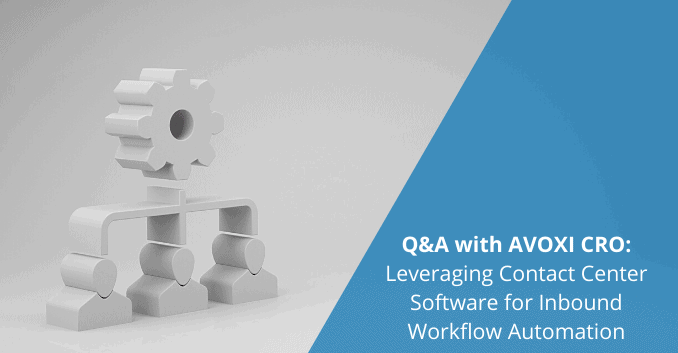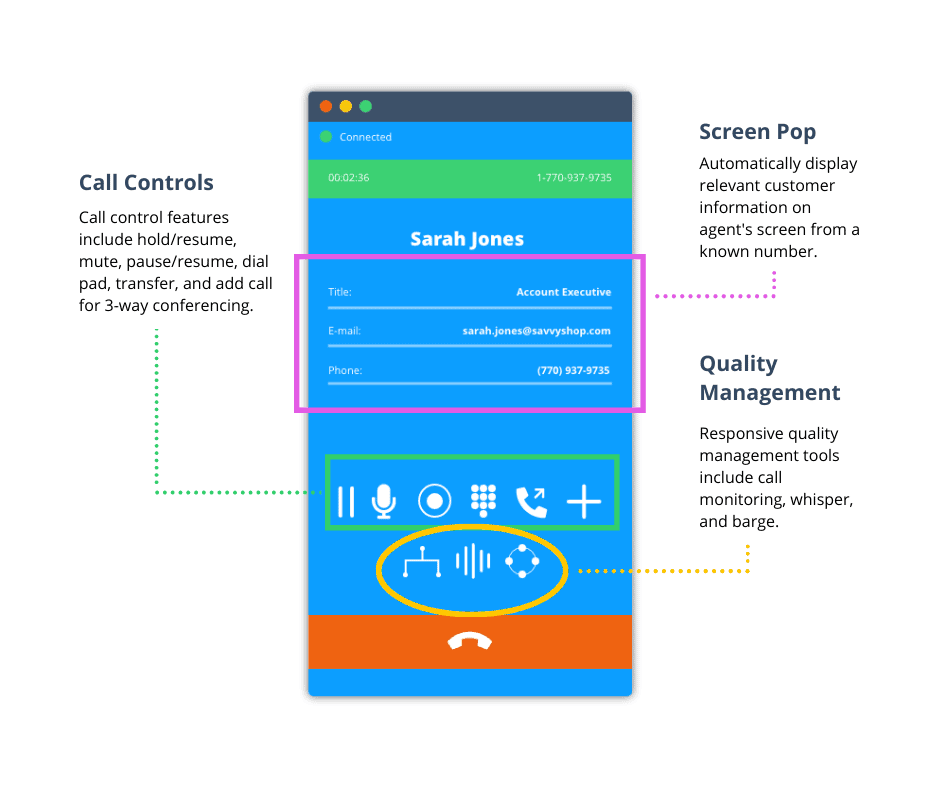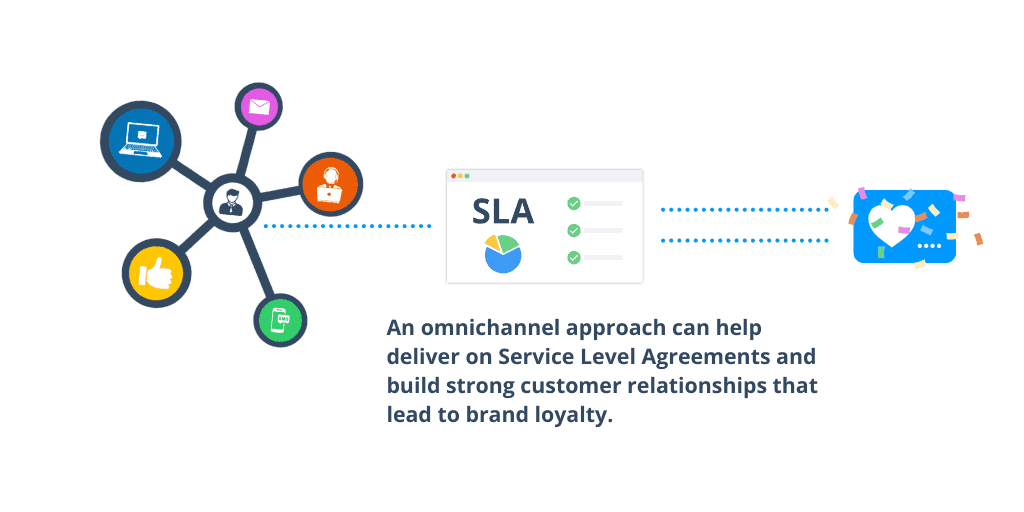Leveraging Contact Center Software for Inbound Workflow Automation

Inbound sales teams go through an extensive process to convert leads into customers. Sales reps have a series of touchpoints to hit on before a sale is made. According to HubSpot, it takes an average of 8 touchpoints to close. Adapting the sales process to each buyer through unique conversations and relationship-building techniques paves the way for new talk channels and a lot more data to analyze.
As more and more companies are moving toward an omnichannel strategy to boost sales, there’s an ever-growing need for workflow automation to bring peace-of-mind to their inbound teams. Couple all this with the pandemic striking earlier this year, it leaves no doubt that teams are looking for any amount of efficiency they can get their hands on.
One of the main tools that inbound teams rely on is contact centers. With numerous integration technologies, automation tools, and data and analytics measurement in place, reps look to inbound cloud-based contact centers to optimize their sales processes and workflow automation to achieve quotas.
Kyle Johnson, Chief Revenue Officer at AVOXI, recently shared how inbound sales teams can directly benefit from cloud contact center software. In our conversation, he discusses how inbound teams are leveraging this software to work smarter and more effectively by automating tedious internal sales processes that would otherwise slow teams down.
Q: How can AVOXI automate tasks and improve internal processes for inbound sales teams?
“We’ve focused heavily on automation within our own platform and integrations into tech tools that our customers are using,” says Johnson. “Our CRM integrations take advantage of CTI - connecting your communication system to your CRM - which automatically logs your calls to save your agents’ time.”
Having automation tools allow inbound sales teams to better handle large call volumes and nurture new relationships. The powerful combination of Computer Telephony Integration (CTI) and Customer Relationship Management (CRM) integration delivers substantial call data and features, such as Screen Pop, to improve rep performance and productivity benchmarks.
Another enjoyable attribute that reps find beneficial to their inbound process is automatic call logging. Removing the grunt work and incorporating automation into workflow gives reps more time back in their day to convert more leads. This feature supports their capacity by quickly adding notes and Disposition Labels on call details that can be tracked over time. As bandwidth opens up, sales reps can dedicate more time to serving their prospects efficiently.
Q: Does your inbound sales team use the platform? If so, what are some of their most-used features?
“Absolutely! We utilize our platform for each of our routes to market internationally as well as our customer support teams who are spread out across the globe,” says Johnson. “From an inbound rep standpoint, our SFDC integration and Call Recording features are used the most.”
AVOXI’s SFDC contact center provides useful CTI features like automatic call logging, Screen Pop, Softphone, Click-to-Call, and many more VoIP benefits that drive better conversations and simplifying work processes. The SFDC integration pops the contact information and notes on the inbound call, so representatives can quickly have a more informed and relevant conversation. It then automatically logs that interaction back into the CRM - simple as that!
Call Recording is another feature to improve sales conversations through coaching and feedback. Supervisors often record calls for quality assurance and training purposes. New hires, as well as those who need a refresher, can listen to previous recordings and learn the proper compliance and procedure as set by the company.

Q: What KPIs do you monitor to see how your inbound sales team is performing? Are there any you monitor to see efficiency improvements?
“We look at several KPIs on a daily basis. Average Speed of Answer and Average Call Length to measure how we’re serving our customers and conversion rates of inbound opportunities to help us identify areas that our team may need additional training,” says Johnson.
Tracking and understanding call center metrics can help with critical decision making. Average Speed of Answer - for example - is the average amount of time it takes a sales rep to answer a phone call. Average Call Length is the average amount of time spent total on each call - also referred to as Average Call Duration.
These two metrics are important to measure because they help determine where additional training and resources are needed. AVOXI’s Advanced Analytics gives sales representatives key insight into how they’re performing on the phones. Service-level metrics and reporting dashboards encourage reps to monitor their performance activities and keep pace with others. It’s important to review your inbound KPIs and benchmarks regularly to track progress.
Q: COVID-19 has shifted several business operations from an office environment to home. How important is it in your opinion to have a cloud-based platform that can support business continuity through unexpected business interruptions like the global pandemic?
“It’s one of the MOST IMPORTANT decisions a business can make. A business’s communication platform is mission-critical - you could call it the lifeblood of the business. There can be a huge financial impact on your business if the ability to sell to and/or serve customers is interrupted, even for a short period of time,” says Johnson.
AVOXI was purpose-built as a cloud communications provider that safeguards businesses from unforeseen disruptions. As the global pandemic quickly forced several call centers to go remote, AVOXI’s platform provided them the adaptability and peace-of-mind to continue operations as if they were back in the office. It’s very intuitive and can be accessed from anywhere with an Internet connection.
Unlike cloud contact centers, on-prems lack the ability to adapt to a changing environment. Having a solution that adapts and scales at a moment’s notice is of utmost importance, especially when businesses are experiencing an influx of calls resulting from something outside of their control. There’s a great need for business continuity at a time like this, and you’ll be happy to know that your calls are being re-routed to another team when the unexpected happens.
Q: How do you foresee contact center software evolving in 2021? And, how will this benefit (if at all) the inbound sales processes?
“I see contact center software continuing to move toward omnichannel and omnitechnology into 2021,” says Johnson. “Businesses are looking to consolidate their platforms into a single-view or pane to manage their customer interactions. We will continue to see more and more automation of simple tasks to reduce the effort on the sales and support representatives, as well as lowering the overall cost for the business to sell to and support their customers. The more efficient the platform can make the rep by tying together their CRM, messaging, intelligent call routing, etc., the better the customer experience is delivered at a reduced cost for the business.”
Communication consistency and message alignment are the driving forces behind omnichannel strategy and omnitechnology. Businesses are focusing on more integrated customer experiences by creating unified and singular messaging between customers and reps across several touchpoints and devices.

Whether it’s incorporating voice, SMS-text, email, social, messaging apps, or chat into your communication strategy, an omnichannel approach can help build stronger relationships and customer loyalty. Channel adoptions are great for delivering on your SLAs, especially if those promises are of fast response times and quick resolutions. Look at your cloud contact center as the power core for all of your communications. More channels and technology brings a greater need for coherent messaging, and cloud communication providers like AVOXI keep the conversations on-brand and customers exceptionally satisfied.
Q: What features provide customers the greatest ROI?
“While the use-case varies across industries, I’d have to say that the two most popular features are Live Dashboards and Call Coaching,” says Johnson.
Data collection is critical for operational success. Live Dashboard from AVOXI provides sales reps with real-time visibility into their call center performance, providing them a quantitative viewpoint to measure and keep pace with other team members within the group. This type of intelligence helps track and monitor call center activity, which can greatly influence high-stakes decisions within the company.
Call Coaching is a qualitative measurement tool that ensures customers are getting a quality experience on every phone call. Sales reps can listen in on calls as they take place, and supervisors can coach their team with same-side feedback or take control of the conversation at any point with Call Monitoring Software. This feature is very important for standardizing team processes and training while ultimately, improving the customer experience and call center benchmarks.
Q: How does AVOXI compare to other contact center solutions?
“Our customers love AVOXI’s integration capabilities, as it helps to streamline their business and communication processes,” says Johnson. “Another great advantage is how quickly we can get our customers’ contact center up and running, especially as so many companies are continuing to operate remotely.”
While many cloud communication providers have similar features for the markets they serve, it’s AVOXI's ability to integrate with several cloud technologies that set us apart. We’re constantly adding new business tools to our portfolio so our customers’ teams can proactively engage with their contacts on their CRM, Helpdesk, or AVOXI software with 2-way Data Synchronization.
Our dedicated installation team and success managers can get cloud contact centers up and running within just a few hours. We make sure that end-users are fully trained and proficient on the product so they’re immersed in the full value of the platform, including integrations, custom reporting and analytics, workflow alignment, and responsive quality management tools.
Leveraging Cloud Communication for Inbound Sales Teams
Cloud contact center software creates an optimized communication system for inbound sales teams that on-prems just can’t compete with. The affordable, easily scalable, and highly adaptable infrastructure keeps operations moving forward thanks to workflow automation and integrations that are accessible from any computer and Internet connection around the world.
Leveraging this cloud system improves your customer communication through business tools you use every day, such as CRM or Helpdesk. Incorporating new channels into your contact center software will bring a wave of new interactions and a lot more data. Intuitive reporting can help you make decisions that are not only right for your team but the state of the business as a whole. Are you ready to explore AVOXI’s contact center for yourself?
